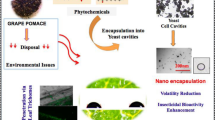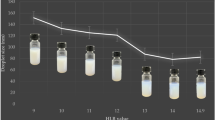Abstract
Existing pesticide formulation solvents generate volatile organic compounds (VOCs), are combustible, and are classed as hazardous air pollutants (HAPs), meaning they are detrimental to users and phytotoxic to crops. Green solvents are required in formulations due to regulations, health, and environmental concerns. In emulsifiable concentration (EC) formulations, the “green chemistry” movement has led to the use of less harmful solvents. After a detailed and comparative fungal growth inhibition assessment, the least harmful carrier solvent among four regularly used organic solvents [dimethyl sulfoxide (DMSO), dimethylformamide (DMF), aromatic hydrocarbon (C9), and methyl oleate] was chosen in this study. We employed methyl oleate (cis-9-Octadecenoic acid methyl ester) as a bio-based green reserver (60%) to create effective bioinspired EC formulations (30%) of Pongamia pinnata L extract utilising emulsifier blends (10 percent) based on the known toxicity order (DMF > DMSO > C9 > methyl oleate). EC1 outperformed the other thirteen formulations (EC1-EC13) in terms of emulsion stability, cold test, accelerated storage stability, flash point, and other metrics, proving its suitability for commercial production. Using four therapeutically appropriate concentrations of agricultural usage, in-vitro fungicidal effects against Alternaria solani and Phytophthora spp. were examined.A. solani (EC50 = 0.08 percent) showed the greatest growth suppression (87.4 percent) at the maximum dosage (1 percent), followed by Phytophthora sp. (71.1 percent) (EC50 = 0.49 percent). The study proved its utility in the production of environmentally acceptable green solvent-based herbal formulations as a long-term crop protection alternative to harmful chemical pesticides.




Similar content being viewed by others
References
Bhandari G, Atreya K, Scheepers PTJ, Geissen V (2020) Concentration and distribution of pesticide residues in soil. Non-dietary human health risk assessment. Chemosphere 253:1–13. https://doi.org/10.1016/j.chemosphere.2020.126594
BIS Specification (1997) Indian standardmethods of test for pesticides and their formulations. IS: First Revision 6940–1982
Bitonto L, Pastore C (2019) Metal hydrated-salts as efficient and reusable catalysts for pre-treating waste cooking oils and animal fats for an effective production of biodiesel. Renewable Energy 143:1193–1200. https://doi.org/10.1016/j.renene.2019.05.100
Borges DF, Lopes EA, Moraes ARF, Soares MS, Visotto LE, Oliveira CR, Valente VMM (2018) Formulation of botanicals for the control of plant-pathogens: a review. Crop Protec 110:135–140. https://doi.org/10.1016/j.cropro.2018.04.003
Campos EVR, Proenca PLF, Oliveira JL, Bakshi M, Abhilash PC, Fraceto LF (2018) Use of botanical insecticides for sustainable agriculture: future perspectives. Ecol Indic. https://doi.org/10.1016/j.ecolind.2018.04.038
Chin CP, Lan CW, Wu HS (2012a) Application of biodiesel as carrier for insecticide emulsifiable concentrate formulation. J Taiwan Inst Chem Eng 43:78–584
Chin CP, Lan CW, Wu HS (2012b) Study on the performanceof lambda cyhalothrin microemulsion with biodiesel as an alternative solvent. Ind Eng Chem Res 51(12):4710–4718
CIPAC MT 18 (1995) Preparation of standard waters A and D. In: Dobrat 255 W, Martijn A eds. CIPAC handbook F. Physico-chemical methods for technical and formulated pesticides.Harpenden, England: Collaborative International Pesticides AnalyticalCouncil Ltd. 59–62
CIPAC MT 36.3 (2003) Emulsion stability and re-emulsification in: Dobrat W, Martijn A, eds. CIPAC handbook K. Physico-chemical methods for technical and formulated pesticides. Harpenden, England: Collaborative International Pesticides Analytical Council Ltd. 137
CIPAC MT 46.3 (2000) Accelerated storage procedure. In: Dobrat W, Martijn A, editors.CIPAC handbook J. Physico-chemical methods for technical and formulated pesticides.Harpenden, England: Collaborative International Pesticides Analytical Council Ltd. 128
CIPAC MT 75.3. (2000) Determination of pH. In: Dobrat W, Martijn A, editors. CIPAC handbook J. Physico-chemical methods for technical and formulated pesticides. Harpenden, England: Collaborative International Pesticides Analytical Council Ltd. 131
CIPAC MT12 (1995) Flash point. In: Dobrat W, Martijn A, editors. CIPAC handbook F. Physico chemical methods for technical and formulated pesticides.Harpenden, England: Collaborative International Pesticides Analytical Council Ltd. 1
Donglu X, Haiyan Y, Puchao L, Guangze L, Jian K, Fuming C, Mingzhang C, Min L (2012) Pesticide solvent using jatropha curcas source, and preparation method and application for pesticide solvent. Patent no: CN 102907418A
Dyrda G, Boniewska-Bernacka E, Man D, Barchiewicz K, Słota R (2019) The effect of organic solvents on selected microorganisms and model liposome membrane. Mol Biol Rep 46:3225–3232. https://doi.org/10.1007/s11033-019-04782-y
EPA (2009c) Screening-Level Hazard Characterization. Alkylphenols Category. http://www.epa.gov/chemrtk/hpvis/hazchar/Category_Alkylphenols_Sept2009.pdf
Fernandes CP, Mascarenhas MP, Zibetti FM, Lima BG, Oliveira RPRF, Rocha L, Falcao DQ (2013) HLB value, an important parameter for the development of essential oil phytopharmaceuticals. Braz J Pharmacog 23:108–114. https://doi.org/10.1590/S0102-695X2012005000127
Gao J, Wang F, Jiang W, Miao J, Wang P, Zhou Z, Liu D (2020) A full evaluation of chiral phenylpyrazole pesticide flufiprole and the metabolites to non-target organism in paddy field. Environ Pollu 264:114808. https://doi.org/10.1016/j.envpol.2020.114808
Hazen KC (2013) Influence of DMSO on antifungal activity during susceptibility testing in vitro. Diagn Microbiol Infect Dis 75(1):60–63. https://doi.org/10.1016/j.diagmicrobio.2012.09.002
Jamiolkowska A, Kopacki M (2020) Natural compounds against plant pests and pathogens. Nat Remed Pest Dis Weed Control. https://doi.org/10.1016/B978-0-12-819304-4.00005-1
Jume BH, Gabris MA, Nodeh HR, Rezania S, Cho J (2020) Biodiesel production from waste cooking oil using a novel heterogeneous catalyst based on graphene oxide doped metal oxide nanoparticles. Renewable Energy 162:2182–2189. https://doi.org/10.1016/j.renene.2020.10.046
Latha P, Anand T, Ragupathi N, Prakasam V, Samiyappan R (2009) Antimicrobial activity of plant extracts and induction of systemic resistance in tomato plants by mixtures of pgpr strains and zimmu leaf extract against. Altern Solani 50(2):85–93. https://doi.org/10.1016/j.biocontrol.2009.03.002
Lees AK, Roberts DM, Lynott J, Sullivan L, Brierley JL (2019) Real-Time PCR and LAMP assays for the detection of spores of Alternaria solani and sporangia of Phytophthora infestans to inform disease risk forecasting. Plant Dis 103(12):3172–3180. https://doi.org/10.1094/PDIS-04-19-0765-RE
Lengai GMW, Muthomi JW, Mbega ER (2019) Phytochemical activity and role of botanical pesticides in pest management for sustainable agricultural crop production. Sci Afric 7:e00239. https://doi.org/10.1016/j.sciaf.2019.e00239
More DR, Baig MMV (2013) Fungitoxic properties of Pongamia pinnata (L) Pierre extracts against pathogenic fungi. Int J Adv Biotechnol Res 4(4):560–567
Morya S, Amoah AEDD, Snaebjornsson SO (2020) Microorganisms for sustainable environment and health. Food poisoning hazards and their consequences over food safety. 383–400. Elsevior.
Mugao LG, Muturi PW, Gichimu BM, Njoroge EK (2020) In-vitro control of Phytophthora infestans and Alternaria solani using crude extracts and essential oils from selected plants. Intern J Agron 2020:1–10. https://doi.org/10.1155/2020/8845692
Mukhtar NAM, Abd Rashid A, Hagos Ftwi Y, Noor MM, Kadirgama K, Rizalman M, Adam AA (2019) The influence of formulation ratio and emulsifying settings on tri-fuel (diesel–ethanol–biodiesel) emulsion properties. Energies 12(9):1708. https://doi.org/10.3390/en12091708
Okumura Y, Koyama J, Takaku H, Satoh H (2001) Influence of organic solvents on the growth of marine microalgae. Archiv Environ Cont Toxicol 41(2):123–128. https://doi.org/10.1007/s002440010229
OSHA Hazard Communication Standard (2012) https://www.osha.gov/dsg/hazcom/ (Accessed on 2021).
Pan L, Chang P, Jin J, Yang Q, Xing F (2020) Dimethylformamide inhibits fungal growth and aflatoxin b1 biosynthesis in Aspergillus flavus by down-regulating glucose metabolism and amino acid biosynthesis. Toxins 12(11):683. https://doi.org/10.3390/toxins12110683
Petruccelli V, Brasili E, Varone L, Valletta A, Pasqua G (2020) Antifungal activity of dimethyl sulfoxide against Botrytis cinerea and phytotoxicity on tomato and lettuce plants. Plant Biosys Intern J Deal All Aspect Plant Biol 154(4):455–462. https://doi.org/10.1080/11263504.2020.1779846
Ping H, Hongmei Y, Donghui W, Jianhua L, Guohua Z, Jianfeng Y, Chunlin W, Baojiang D (2016) Dimethyl dichloroviny phosphate emulsifiable concentrate and preparation method thereof. Patent no: CN 105613566
Pubchem, NIH, US, National Library of Medicine, National central for biotechnology information. https://pubchem.ncbi.nlm.nih.gov/ (Accessed on 2021)
Purkait A, Biswas S, Saha S, Hazra DK, Roy K, Biswas PK, Ghosh SK, Kole RK (2019) Formulation of plant based insecticides, their bio-efficacy evaluation and chemical characterization. Crop Prot 125:104907. https://doi.org/10.1016/j.cropro.2019.104907
Raja RR, Sreenivasulu M (2016) Pongamia Pinnata—Phytotherapeutic review. World J Pharm Res 5(4):505–511
Randhawa MA (2006) The effect of dimethyl sulfoxide (DMSO) on the growth of dermatophytes. Nippon Ishinkin Gakkai Zasshi 47(4):313–318. https://doi.org/10.3314/jjmm.47.313
Rani A, Shukla G, Sing R, Kumar A, Girdharwal V (2015) Antifungal activity of plant extracts against Phytophthora in festans. Intern J Sci Res 4(8):666–668
Rani A, Singh R, Kumar P, Shukla G, Singh C (2017) Ecofriendly management of late blight of potato caused by Phytophthora infestans (L). Intern J Pharm Res Technol 1:21–27
Rani L, Thapa K, Kanojia N, Sharma N, Singh Sukhbir G, Ajmer S, Srivastav AL, Kaushal J (2020) An extensive review on the consequences of chemical pesticides on human health and environment. J Clean Prod. https://doi.org/10.1016/j.jclepro.2020.124657
Sarpong MT (2016) In vitro evaluation of the effect of selected plant extracts on the Phytophthora fungus causing disease in MD2 variety of pineapple in the central region of Ghana. EC Microbiol 4(1):623–632
Satish Kumar BN (2011) Pharmacological studies of Pongamia pinnata (Linn.) Pierre. Int J Pharm Sci Rev Res 9:12–19
Shaheen I, Parveen S, Parveen Z (2017) Evaluation of Pongamia pinnata products against the Sclerotium rolfsii extracted from chickpea. Adv Crop Sci Tech 5:291. https://doi.org/10.4172/2329-8863.1000291
Thakur LK, Roy S, Prajapati R, Singh MK, Raza SK, Mangave BD, Singh A, Jha S (2014) Development and evaluation of environment & user friendly turmeric oil emulsifiable concentrate (EC) formulations for postharvest quality and life in rose CV. Poison Int J Recent Sci Res 5:178–185
WHO (2001) Concise International Chemical Assessment Document 31https://www.who.int/ipcs/publications/cicad/en/cicad31.pdf?ua=1 (Accessed on 2021).
Yoneyama M, Masubuchi M, Oishi S, Takahashi O, Ikawa M, Yoshida S, Oishi H, Mikuriya H, Yuzawa K, Hiraga K (1977) Subacute toxicity of linear alkylbenzene sulfonate. Ann. Rep. Tokyo Metrop. Res. Lab. Public Health 28:73–84 (in Japanese); cited in: IPCS (1996); Environmental Health Criteria 169: Linear Alkylbenzene Sulfonates (LAS) and Related Compounds. WHO, Geneva,Switzerland.
Zhang XP, Jing TF, Zhang DX, Luo J, Li BX, Liu F (2018) Assessment of ethylene glycol diacetate as an alternative carrier for use in agrochemical emulsifiable concentrate formulation. Ecotoxicol Environ Saf 163:349–355
Acknowledgements
The writers are thankful to Agro-Chemical Formulation Laboratory, Department of Agricultural Chemicals, Bidhan Chandra Krishi Viswavidyalaya (BCKV), Nadia, West Bengal, India for providing the facilities for this research.
Funding
The completion of this research work was done without any financial assistance.
Author information
Authors and Affiliations
Contributions
D.K.H. and R.K.K. wrote the main manuscript text. A.P. and D.R. prepared the figures. A.B. and P.K.B. prepared all tables. All authors reviewed the manuscript.
Corresponding author
Ethics declarations
Conflicts of interest
The authors declare no conflict of interests.
Additional information
Communicated by Erko Stackebrandt.
Publisher's Note
Springer Nature remains neutral with regard to jurisdictional claims in published maps and institutional affiliations.
Rights and permissions
Springer Nature or its licensor holds exclusive rights to this article under a publishing agreement with the author(s) or other rightsholder(s); author self-archiving of the accepted manuscript version of this article is solely governed by the terms of such publishing agreement and applicable law.
About this article
Cite this article
Purkait, A., Rana, D., Banerjee, A. et al. Selection of green carrier solvent for the effective creation of bio-inspired liquid formulation and anti-fungal potency evaluation. Arch Microbiol 204, 669 (2022). https://doi.org/10.1007/s00203-022-03280-3
Received:
Accepted:
Published:
DOI: https://doi.org/10.1007/s00203-022-03280-3




